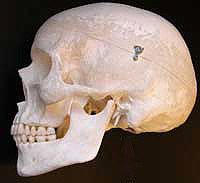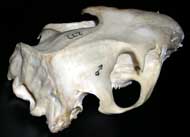Animal Adaptations: Hominid Skulls
Below is a pictorial review of important features for comparing hominid skulls. |
|
Several features of skulls provide information about the lifestyles of the organisms in question. This is especially useful with fossils, because such ancient organisms are often extinct and we can't go out and watch how they live. |

|
Zygomatic arches
These bones arc from the cheek area toward the ears, and are very prominent in this Australopithecus model (left). They provide attachment points for the muscles of the lower jaw. The size of the lower jaw is correlated with the size and prominence of the zygomatic arches. Large, muscular jaws require large arches for attachment. Animals that use their jaws for defense or that eat tough foods requiring heavy chewing need large, muscular jaws.
Of the hominids, humans have the most petite jaws and also the smallest zygomatic arches (visible in the right-hand photo below). Humans do not regularly defend themselves by biting and process their foods so that they are easier to chew. We are also omnivorous, and don't rely as heavily on eating leaves as some other primates.
|
|
Foramen magnum
This is the hole near the base of the skull where the spinal cord would connect. The position of this hole in relation to the jaw provides information on whether the animal walked upright or on all fours. |
|
Foramen magnum
In humans, the foramen magnum is directly beneath the skull (left). If you drew one line through the teeth and another line through the foramen magnum, the two lines would cross (right). This placement of the foramen magnum in relation to the jaw is typical of animals that walk upright, with their heads balanced over their shoulders. |
 |
|
|
Foramen magnum
In squirrels, the foramen magnum is at the back of the skull rather than under it (left). If you drew one line through the teeth and another through the foramen magnum, the lines would be parallel (right). Animals that walk on all fours and hold their heads out in front of them have this placement of the foramen magnum relative to the jaw. |
 |
|
|